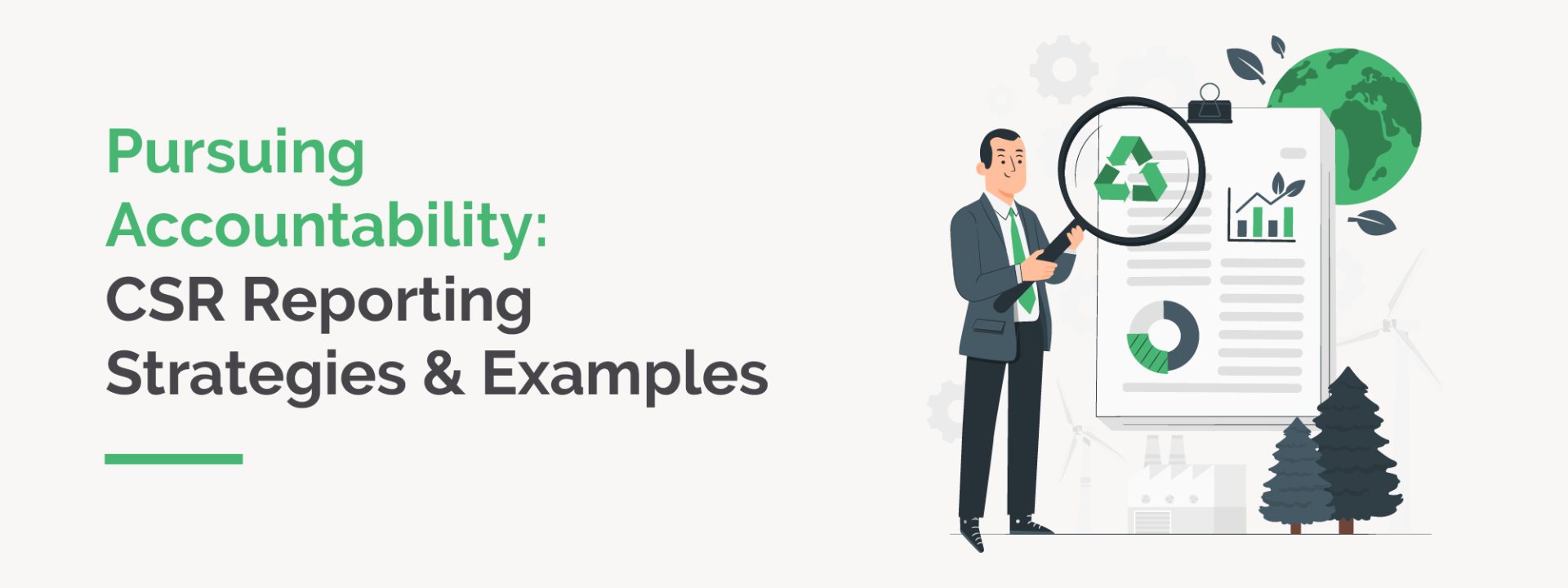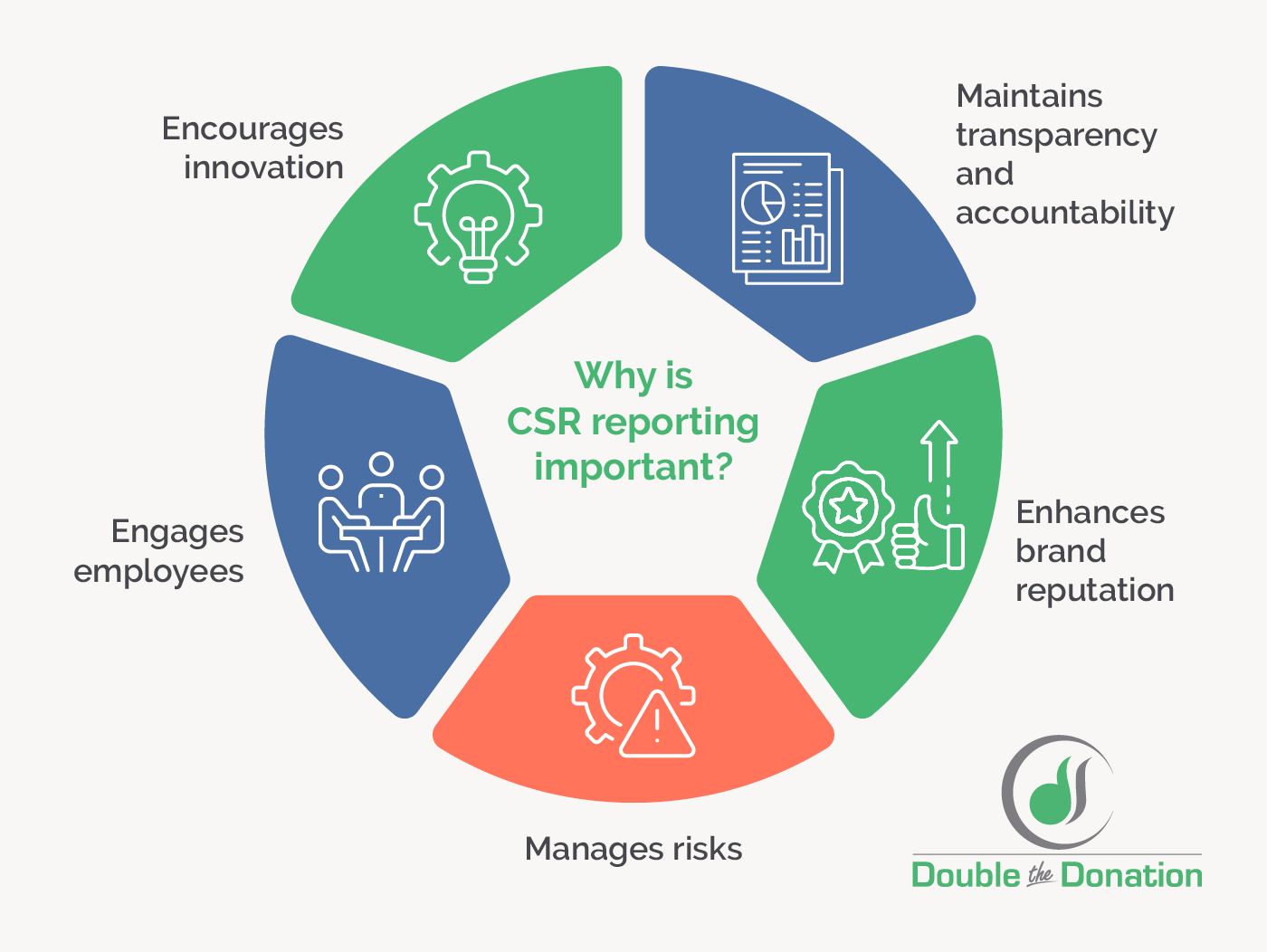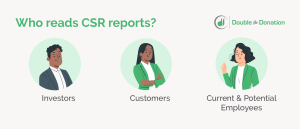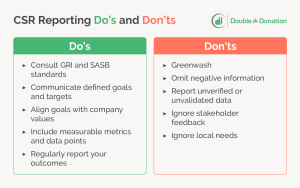Pursuing Accountability: CSR Reporting Strategies & Examples
CSR reporting is an increasingly popular way for businesses to display their sustainability performance and build credibility. A compelling CSR report can strengthen corporate relationships between employees, stakeholders, and consumers. In this guide, we’ll explore the ins and outs of CSR reporting by covering the following topics:
- What is Corporate Social Responsibility (CSR)?
- What is CSR Reporting?
- Why is CSR Reporting Important?
- Who Reads CSR Reports?
- What Should a CSR Report Include?
- Strategies to Strengthen Your CSR Report
- CSR Report Examples to Emulate
Keep in mind there is no “perfect” CSR report to rely on. Instead, your CSR report should encapsulate your company’s values and show tangible evidence of its commitment to responsibly steward its resources and influence.
What is Corporate Social Responsibility (CSR)?
Corporate social responsibility also known as CSR or corporate citizenship describes a company’s efforts to improve society in some way.
These efforts fall into several categories such as volunteering, donating cash or in-kind goods or services, or changing operational systems to benefit environmental or social justice-related causes. Although it is not a mandated practice in the U.S., CSR positively impacts companies, employees, and society as a whole and can function as a meaningful differentiator for companies that participate.
What is CSR Reporting?
A CSR report, also known as an extra-financial report or an ESG (environmental social governance) report, is a document published by a company (usually annually) to provide evidence of its CSR efforts and results.
Although there is not a common set of reporting standards in the U.S., typically a CSR report captures at least one of the four categories: environmental, ethical, philanthropic, or economic impact.
Is CSR Reporting Mandatory?
Sustainability reporting falls under ESG reporting which stands for environmental, social, and governance reporting which acts as a quantifiable measurement of a company’s social impact outcome.
Currently, U.S.-based companies are not legally required to provide an ESG report. However, all companies are encouraged to produce ESG reports to provide company insights that pave the way for a more sustainable future.
The United States Security and Exchange Commission (SEC) only requires companies to report on information that may be material to investors, including ESG-related risks. This policy could change soon as the SEC proposed in May 2022 certain “amendments to rules and reporting forms to promote consistent, comparable, and reliable information for investors concerning funds’ and advisers’ incorporation of environmental, social, and governance (ESG) factors.”
That said, delivering a CSR report should be about more than just maintaining potential legal compliance. Instead, it’s about demonstrating your commitment to making the world a better place through responsible stewardship of resources.
Why is CSR Reporting Important?
Aside from the positive societal and environmental impact it accounts for, CSR reporting is important because it communicates and provides evidence for your company’s values. To break it down further, comprehensive CSR reporting accomplishes the following objectives:
- Maintains transparency and accountability. A CSR report discloses a company’s societal and environmental impacts, initiatives, and performance to stakeholders. Often, it’s a means of establishing or strengthening trust as it indicates a commitment to ethical decision-making.
- Enhances brand reputation. Companies that document their CSR initiatives stand out among others as leaders in the social good space. A strong CSR program and transparent reporting can also bring more socially conscious consumers, stakeholders, and employees.
- Manages risks. CSR reporting enables companies to proactively identify and mitigate social and environmental risks. For example, a company may opt for a greener supply chain management process or roll out a new Diversity, Equity, and Inclusion (DEI) policy to welcome a more diverse workforce.
- Engages employees. CSR reporting can increase employee morale and engagement by showing a company cares about its local and global community more than just making a profit. For example, 83% of employees would consider leaving their jobs if the company displayed irresponsible CSR practices.
- Encourages innovation. To reach CSR goals, companies sometimes invest in research and development of sustainable products and processes that can lead to cost savings and open up new revenue streams.
For all these reasons, CSR reporting should be a staple at every socially responsible organization as doing so will ensure a company’s internal aims align with its actions. And, if the United States decides to follow the European Union’s lead and enforce distinct reporting standards, companies well-versed in CSR reporting will already have a leg up.
Who Reads CSR Reports?
When writing any report, knowing your audience and why they’d be interested in reading it is helpful. In the case of a CSR report, the document will target both internal and external parties. Let’s take a look at each below.
Investors
Investors are interested in CSR reports because they want to assess your company’s long-term sustainability and ethical practices. Specifically, they evaluate ESG risks and the strategies your company has in place to mitigate them.
Investors are also concerned with your company’s financial performance, so a data-backed CSR report that details associated cost savings and market share increase can be a valuable asset for attracting this group.
Customers
Customers read CSR reports to make informed purchasing decisions that align with their values. For example, 50% of survey respondents even reported conducting online research to see how a business reacts to social issues before making a buying decision.
Remember a customer’s perspective when finalizing your report. For example, a local company may opt to highlight its local community involvement through programs or partnerships. This also translates to choosing engaging imagery and using customer-friendly language.
Current and potential employees
Employees read CSR reports to better understand their employer’s values, ethics, and contributions to society to see if their values align. More recently, employees have noted that CSR is a paramount decision-making factor for new employees as 93% believe companies must lead with purpose.
Therefore, your CSR report can also act as a retention and recruitment tool by plan by highlighting your company’s sustainability and social good plans and accomplishments
What Should a CSR Report Include?
Because CSR reports can vary in length, subject matter, and style, it can be difficult to know where to start. To help you out, we’ve provided CSR reporting do’s and don’ts for you to compare below:
CSR Reporting Do’s
- Consult GRI and SASB standards. The GRI is a nonprofit organization that provides the most widely used CSR reporting standards that range from universal to sector and topic standards. The SASB is an independent organization that develops industry-specific standards for ESG disclosure designed to be compatible with existing financial reporting frameworks. Consult each of these reporting standards throughout your report creation.
- Communicate defined goals and targets. Clearly define your objectives to ensure they line up with the SMART (Specific, Measurable, Achievable, Relevant, Time-bound) framework. For example, a company may aim to decrease carbon emissions by a certain percentage in 2030.
- Align goals with company values. Choose achievable goals that directly relate to your company’s values and business strategy. For example, Disney’s emphasis on ethical storytelling carries on in its commitment to DEI initiatives.
- Include measurable metrics and data points. Include KPIs such as hiring data, emissions targets, volunteer hours, and charitable donations to offer tangible evidence of your CSR progress.
- Regularly report your outcomes. Continue publishing your CSR reports annually or semi-annually to update your documentation. If you have a breakthrough or priority shift for one of your programs, publish an updated version of your report.
CSR Reporting Don’ts
-
-
- Greenwash. Greenwashing involves misleading or making false claims about your organization’s environmental or societal impact in an attempt to appear more socially or environmentally responsible. Avoid exaggerating achievements or using deceptive language to mislead readers. Instead, remain honest and transparent about your CSR initiatives.
- Omit negative information. If your organization did not meet its goal or ran into internal roadblocks, don’t omit this information. Transparency involves sharing successes and challenges as leaving out negative aspects can erode stakeholder trust.
- Report unverified or unvalidated data. Consider engaging external auditors or verification experts to review your data and maintain transparency. Additionally, make sure all data sources are documented within your final report. For example, if you’re reporting on greenhouse gas emissions, cite that the data matches emissions reports from monitoring equipment and third-party audits.
- Ignore stakeholder feedback. Gather feedback from internal and external stakeholders throughout your reporting process. Engaging with them will help you identify and amend data discrepancies and elaborate on vague or inconsistent points.
- Ignore local needs. Your CSR report should be sensitive to the needs and expectations of the community in which you operate. Ignoring local needs can lead to a disconnect between your CSR initiatives and the community. For instance, a company located in a hurricane-prone area might consider aiding in disaster relief as one of its core CSR projects.
-
Strategies to Strengthen Your CSR Reporting
Now that you know the basics of CSR reporting, you might be wondering, How can I take my report to the next level? To start, you’ll want to review your current CSR programs and data collection methods. Other strategies that can take your CSR strategy above and beyond are listed below:
Invest in CSR software
Comprehensive CSR reporting requires that your company keep track of several programs at once spanning from environmental causes to social and economic initiatives. With a CSR platform, your team can manage these historic and incoming data points with ease.
These software solutions make it simple to ingrain your social, environmental, and philanthropic values into your day-to-day operations. This way, you can prioritize your societal impact without sacrificing focus on your company’s growth and long-term success. Aside from streamlining your workflow, CSR platforms can help you reap several benefits, including:
- Enhanced reporting and analytics. Employee engagement software and sustainability management software all have built-in reporting capabilities that will keep you on track. For instance, you can easily measure matching gift participation or revenue generation at a glance.
- Increased transparency and maintain compliance. Some industries have stricter CSR reporting standards than others. CSR platforms streamline the data collection process and generate real-time reports to ensure companies are meeting all the relevant requirements.
- Improved employee engagement. A survey conducted by Paul Polman found that 70% of U.K. employees and 78% of U.S. employees want their company to have a reputation for doing good in society. CSR software encourages businesses to take the reins and cultivate a higher sense of pride through organized CSR programs.
When shopping for the right CSR software, look for a platform that compliments your existing technology. For example, CSR software with an auto-submission integration can skyrocket your employee matching gift participation by making it easier than ever to submit a matching gift request.
This way, when an employee donates to a nonprofit, they only need to submit their corporate email address, and the software automates the rest of the request submission process.
Check out this brief video to understand how the auto-submission feature fits into your CSR strategy:
As seen in the video, CSR software integration can significantly help boost employee participation and elevate your matching gift programs.
Contextualize your data
Your data and performance indicators must be contextualized to be useful for the reader. This means you’ll need to explain the importance of each of your initiatives and provide an honest picture of your progress. Here are a few strategies you can use to offer a complete summary:
- Historical data. Compare your recent data to historical data to show trends and changes over time. For example, you may compare how your company has decreased its carbon emissions over the past decade.
- Industry benchmarks. Compare your data to industry benchmarks and standards such as the Global Reporting Initiative guidelines to provide a frame of reference for stakeholders.
- Geographic or demographic information. If applicable, provide geographic or demographic context about the regions or demographics your initiatives impact. For example, if your company rolls out a clean water initiative, you should provide context concerning the region and people this program will impact.
- External factors. Acknowledge any relevant external factors that may have affected your data including economic shifts, regulatory changes, or natural disasters that have influenced your progress.
- Visual representations. Break down your findings by using a variety of visual representations such as graphs, infographics, and charts to make your data more accessible and help stakeholders quickly grasp your main points.
By adding these strategies to your CSR report, you’ll provide additional clarity to your readers and effectively communicate your sustainability journey. This way, you’ll foster trust and confidence by exploring the full picture of your company’s challenges and successes.
CSR Report Examples to Emulate
Sometimes it’s helpful to have a few examples to refer to when drafting your CSR report. To help guide your research I’ve handpicked three companies with stellar CSR reports and listed what makes each report worth emulating below:
Meta 2023: Forward-Thinking Strategy
The Social Metaverse Company, or Meta, “builds technologies that help people connect, find communities, and grow businesses.” They specialize in creating immersive technologies that facilitate new social experiences.
Meta’s 2023 CSR report’s forward-thinking strategy makes it worth considering. The company’s concrete and transparent approach to net zero emissions gives the reader a better understanding of its strategy. Take a look at its carbon emissions breakdown below:
This graph shows Meta’s 2022 carbon footprint and the description of how it has achieved net zero emissions in its global operations.
Additionally, the report goes on to say that reaching net zero emissions is not enough and lays out a plan to decarbonize it’s footprint beyond its offices and data centers. Specifically, to align with the Paris Agreement, Meta has set a goal to reach net zero emissions across its value chain in 2030.
This forward-thinking approach uses historical data to set both achievable and measurable goals as Meta sets out to design with less, incorporate sustainable supply chain principles, and embrace low-carbon technology.
Campbell Soup: Consistent Branding
The Campell Soup company is committed to “bringing people together through food they love.” The company’s soups, simple meals, snacks, and beverages are in alignment with its health and well-being goals.
Campell Soup’s homestyle messaging rings through in its 2022 CSR report. The report’s clear branding and engaging visuals remind readers of the company’s purpose. Additionally, the programs Campell Soup supports such as its school nutrition partnerships align with its values:
By providing nutrition education in a variety of school settings to support awareness of and pique interest in nutritious food choices, Campbell Soup affirms its dedication to improving food access and education.
This is just one example of a CSR program that is aligned with Campbell’s Soups values. For more details, check out the full report below.
Intel: Effective Collaboration
Intel specializes in providing technology that seeks to improve the life of every person. The company has driven business and society forward with innovation, expertise, and forward-thinking products.
A main thread of the company’s beliefs is interconnectivity which is alive and well within Intel’s CSR report. Multiple letters from company leadership including the CEO and CPO clearly outline the report’s goals.
Additionally, Intel’s emphasis on employee engagement and stakeholder transparency sets it apart. According to the Executive Vice President “Maintaining a strong culture and positive employee relations is paramount as we grow and transform Intel”.
And, Intel’s integrated investor outreach program speaks to its commitment to corporate accountability. By getting the perspective of multiple stakeholders, Intel’s CSR report is an example of effective collaboration. View the report below for more details.
CSR Reporting: Conclusion + Additional Resources
CSR reports are necessary tools to communicate your company’s sustainability and environmental goals. When drafting your report be sure to include accurate and complete data that builds credibility. Consider researching the reports of companies within your sector to get a better understanding of how to structure your report.
We hope you enjoyed this guide to CSR reporting. Check out these resources to continue learning:
- What’s the impact of CSR? FAQ & Key Benefits for Businesses. New to CSR? Read this guide to learn what it is and why it matters for your business.
- Creating a CSR Strategy: How to Forge a Lasting Impact. With so many worthy causes, you might not know where to direct your company’s efforts. Read this guide to learn how to create a successful CSR plan.
- A Smart Guide to Unlocking The Power of CSR Software. The right software makes CSR reporting much easier. Read this guide to understand how CSR software can support your corporate goals.








